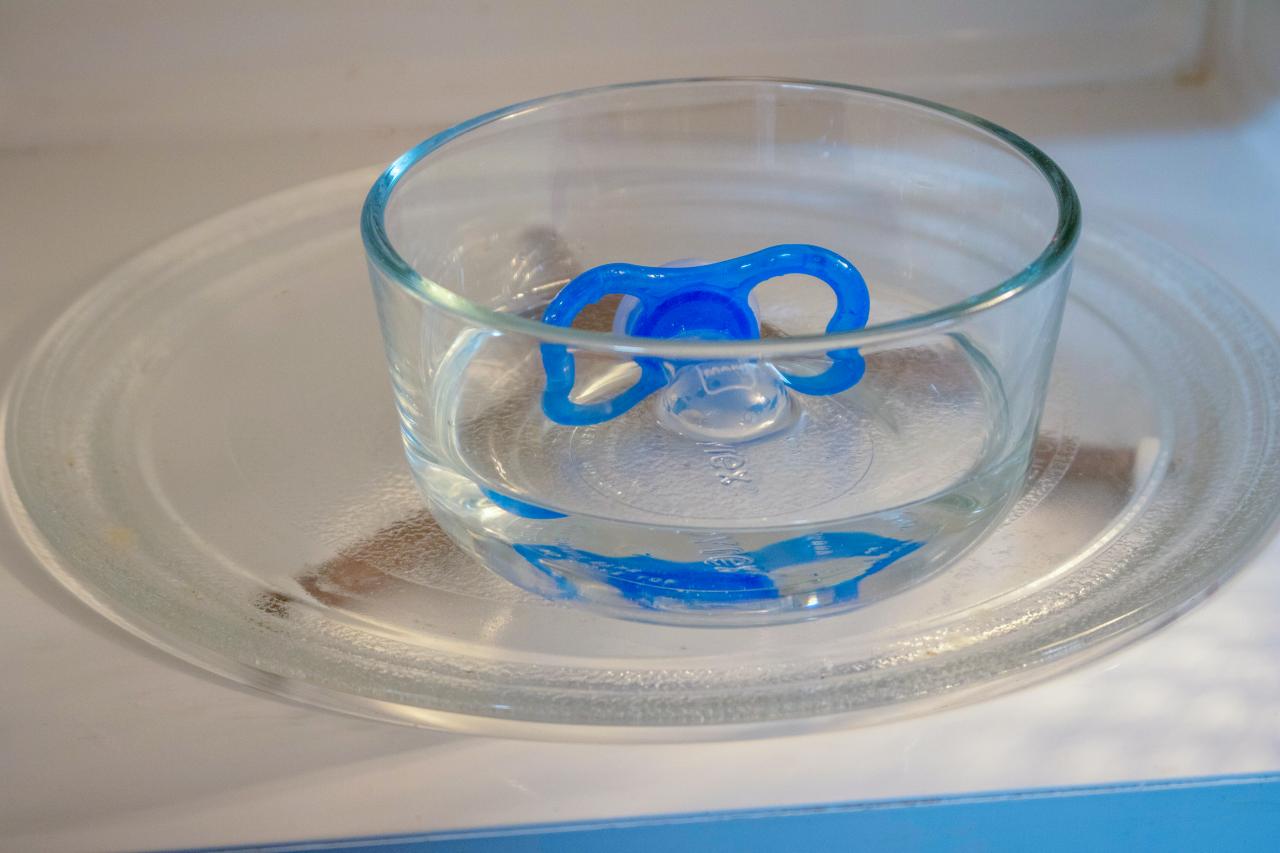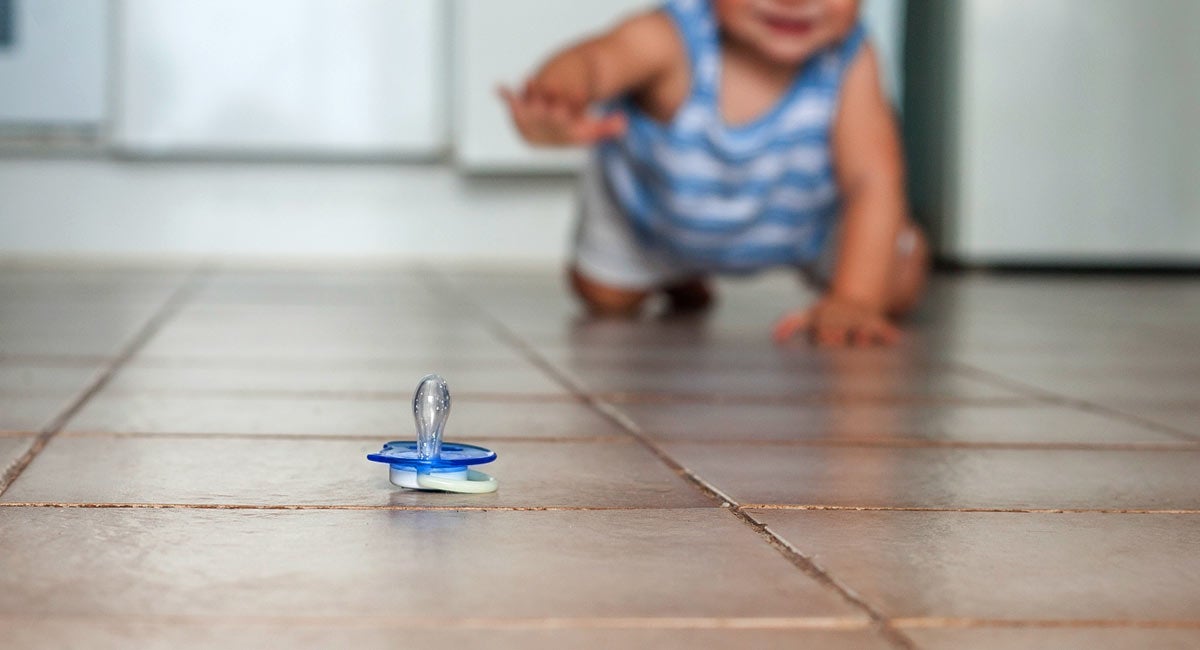Hello, baby! Welcome to the world. Enjoy those first moments as a new parent as you swaddle your baby and soothe her with kisses.
When should you give a pacifier to the baby?
When she is hungry or fussy, a pacifier can be a great way to calm her down and maybe even score herself some much-needed sleep. Although as the parent you may want to do everything possible to ensure your little one stays healthy, some overzealous moms and dads sterilize their baby's pacifiers too much. That could hurt more than it helps...
The American Association of Pediatrics recommends that parents wait until their baby is 6 months old before introducing a pacifier, and only if the baby shows an interest in it. The AAP also suggests that you use the pacifier for naps and bedtime after your baby turns 1 year old. Avoid letting your child fall asleep with his soother if he uses it during the day, as this can increase ear infections. Be sure to follow other safety precautions like limiting your time in the crib while infants are sleeping.
As you spend time with your little one, be sure to pick out a pacifier that's safe for her. The American Dental Association (ADA) recommends that parents sterilize their children's pacifiers by boiling them or running them through the dishwasher before each use.
This helps prevent harmful bacteria from growing on them between feedings and can reduce the risk of ear infections and bacteremia (a bacterial infection of the blood). Here are 5 methods for safely sterilizing your child's pacifiers.
Boil a pacifier
When you're ready to sterilize your baby's pacifier, boil it for 5 minutes. Make sure the water is boiling before you put the pacifier into the water. It should be completely submerged in boiling water.
Boil a large pot of water on the stovetop and place the baby's soother inside, making sure it is fully submerged. Boil for five minutes (do not let them boil longer). Remove carefully with tongs or wear oven mitts as the pot will be hot. Place boiled soother on a clean towel until cool enough to touch, then rinse with clean cool tap water before using again.
Wash pacifiers in the dishwasher
Unplug your dishwasher before putting any plastic parts of the pacifiers into it, or make sure that the pacifier can withstand high temperatures. Place your cleaned soothers in the top rack of the dishwasher and run on a hot cycle. Make sure you have closed any protective covers before putting them to ensure they are clean too.
Wash them by hand in the sink
Simply wash your child's pacifier when he is done with it for the day. You can use soap or boiled water to sterilize it between feedings when necessary, but keeping the soother clean after each use will help reduce bacteria growth. Be sure to rinse well with cool tap water before using it again.
Use wipes to clean them
Buy wet disposable wipes that are made specifically for cleaning baby items like pacifiers. You can use these wipes between feedings or when you are on the go. Throw them away after each use to avoid contamination.

Can you stick a pacifier in your mouth?
You should not use other people's soothers, or let your child use yours. The ADA recommends that the pacifier be one you put in your child's mouth and no one else's to avoid transferring viruses or bacteria from their mouths to your baby.
Be sure to sterilize pacifiers before using them again to lower the risk of ear infections and bacteremia (a bacterial infection of the blood). Follow these simple tips on how to do it.
What materials do you need to sterilize a pacifier?
You will need:
- boiling water or dishwasher (make sure the dishwasher is off)
- clean the dish towel to place your sterilized pacifiers on when they are done. DO NOT use a dirty dishtowel!
- sterile wipes for cleaning in between feedings if you don't want to boil them each time. Do not share yours with your child, that's just nasty.
How do I sterilize my baby's pacifier?
Unscrew the nipple from the plastic cover and remove all of the small parts, like valves and extra nipples if there are any. Place pacifiers in an open pot of boiling water for 5 minutes so that they are fully immersed in it. If you have an electric kettle you can simply use that.
If not, place the pot on the stovetop and turn heat to medium until it boils. To remove with tongs or wear oven mitts because it will be hot. Immediately after boiling your pacifier, dip in a clean dishtowel placed on the counter and allow to air dry before using again (make sure it is COMPLETELY cool).
Wet disposable wipes are available for cleaning between feedings and for when you're on the go. Throw them away after each use to avoid contamination. You should never share your pacifier with your child or let your child use yours.
The ADA recommends that the pacifier be one you put in your child's mouth and no else's to avoid transferring viruses or bacteria from their mouths to your baby. You can also buy drying racks for pacifiers so you don't have to air dry them before putting them back in the case.
NOTE: Do not put a nipple with a plastic cover in boiling water, as it may melt. Be sure to sterilize your child's pacifier between feedings to lower the risk of ear infections and bacteremia (a bacterial infection of the blood). Follow these simple tips on how to do this without any special equipment beyond what comes in most standard baby-care kits.
What is an electric sterilizer?
An electric sterilizer is a special pot for boiling things like pacifiers and baby bottles. This pot will heat up to boiling on its own, so you don't have to attach it to the stove yourself. Boil your child's pacifier or bottle in this pot instead of just heating something up in a saucepan if you want an extra safe method that takes care of everything at once.
What do I need for this?
You'll need:
- electric sterilizer (get one with adjustable steam control)
- clean dish towel or drying rack depending on preference
- new pacifiers or washed ones ready to be boiled (rinse them with cool water before putting them in the sterilizer!) Do not share yours with your child, that's just nasty.
How do I sterilize my baby's pacifier?
Put your pacifiers in the sterilizer before plugging it in to prevent steam burns. Follow the manufacturer's instructions on how much water to add. Some models need cold water while others can be used with cold or hot tap water. Start with cold water and let the electric sterilizer heat up for 5-20 minutes (depending on your model) until it reaches boiling point inside.
After that drop your pacifiers in and close the lid tightly so all of them are covered by at least one inch of boiling liquid inside when closed properly. It is normal for some steam to escape when you open the lid again after adding the pacifiers.
Let them stay in the sterilizer for three minutes before removing them. Unplug your pot and let it cool down without removing the lid, then take out the pacifiers using tongs or oven mitts to avoid being burnt by boiling water or steam.
This is the safest way to sterilize your soothers. If you are using the microwave, you will need to submerge them in water and make sure all parts of it can be immersed. However, this method is not as effective as boiling them with a pot of water on the stovetop.
You can also use a sterilizer that plugs into an outlet for quicker results. These electric steamers come with racks that hold several pacifiers each for fast processing time. This is great if you have more than one child who uses a pacifier because you won't have to wait around while they run through cycles individually. Be sure to check that it comes with tongs or something similar for removing them from the machine without burning yourself when they come out.
How can you care about pacifiers?
You can't boil a pacifier that has been used by someone else.
If you're using a sterilizing pot on the stove, wash it with mild soap and water after each use to keep your pacifiers safe from bacteria. This is especially important if your child doesn't seem to want her pacifier back or if she throws it on the floor regularly after taking it out of her mouth.
Put new pacifiers in boiling water for 3 minutes each before giving them to your baby for that extra safety step.
Wash all pacifiers with hot soapy water that goes into every side of them before every use. Allow them to air dry either flat on a towel or inside a drying. Bacteria love moisture, so keeping them dry longer is important for keeping your baby safe.
Brand new pacifiers should be boiled in water for 5 minutes before they are given to your child. You can trust that these will be free of any bacteria, viruses or other nasties that might have been collected on them at the factory.

Try not to share pacifiers with friends if their children use them too. Different mouths lead to different levels of bacteria buildup depending on each person's immune system strength and overall cleanliness, so it is possible to pass illnesses around if you share a pacifier without cleaning it between uses. This also applies to letting one child use another child's pacifier - do not do this!
If you notice something growing inside of your pacifier, you can sterilize it in boiling water for 5 minutes to get rid of all the gunk. This is generally not harmful if your child is not showing any signs of infection, but it's good practice to keep pacifiers clean.
When should you toss out pacifiers? (you might need an idea of how often to change them)
If the appearance or texture of your pacifier has changed drastically over time either due to wear and tear or bacteria buildup, you should replace it .
Do not let your baby chew on a pacifier cord because they pose a strangulation hazard. (remove cords! All US hospitals recommend this!) Cutting off pieces regularly is best so they don't get long enough that they can be grabbed by your baby.
If you notice that your infant's pacifier has any mold growing on the surface, change it! This can be extremely dangerous for babies because their immune systems are not strong enough to fight off the nasties that grow on them. Mold is most commonly found inside pacifiers because they hold moisture inside, so make sure it's completely dry before giving it back to your little one.
As always, check with your pediatrician whenever you have questions about sterilizing techniques or how often you should replace pacifiers. Some children are at higher risk for developing illnesses due to low immunity levels, so ask what kinds of precautions you need to take with their specific situation.
Final words
Keep pacifiers clean and replace them often. Boiling water is great for disinfecting pacifiers, but make sure you don't overheat them or leave them in the pot too long. If you notice signs of mold growing inside a pacifier, throw it out immediately.
Also, you can use electric pacifiers sterilizers, which is a great help. Above all else, make sure not to share a pacifier with your baby's friends or let one child use another's - this poses a huge threat to their health!
